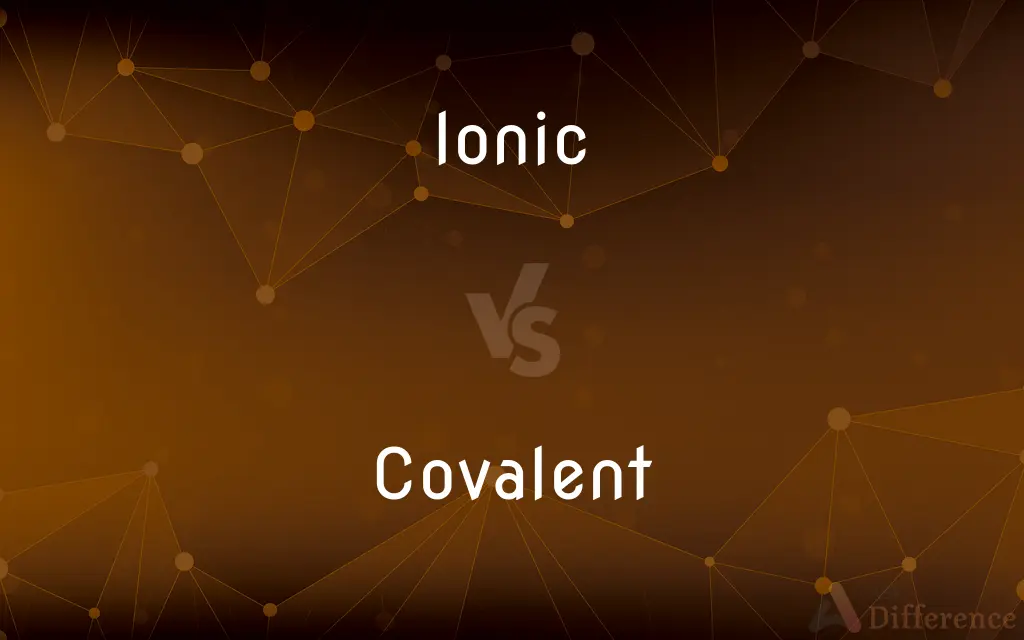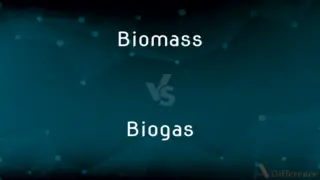Ionic vs. Covalent — What's the Difference?
By Maham Liaqat & Urooj Arif — Updated on March 8, 2024
Ionic bonds form through the transfer of electrons, while covalent bonds result from the sharing of electrons.

Difference Between Ionic and Covalent
Table of Contents
ADVERTISEMENT
Key Differences
Ionic bonding occurs when electrons are transferred from one atom (typically a metal) to another (typically a nonmetal), creating ions that are held together by electrostatic forces. This process results in a compound with a positive ion (cation) and a negative ion (anion). Covalent bonding, on the other hand, involves the sharing of electron pairs between atoms, typically nonmetals, allowing them to achieve stable electron configurations.
Ionic compounds usually have high melting and boiling points due to the strong forces between ions, leading to solid states at room temperature. Covalent compounds, with their varying bond strengths, can exist as gases, liquids, or solids under normal conditions, often with lower melting and boiling points than ionic compounds.
Ionic bonds create compounds that are typically good conductors of electricity when dissolved in water or melted, due to the movement of ions. Covalent compounds, especially those that are molecular, do not conduct electricity in such states because they do not have charged particles that are free to move.
The solubility of ionic compounds in water is generally high because water molecules can easily hydrate and stabilize the ions. Covalent compounds vary greatly in their solubility in water, with polar covalent compounds being more likely to dissolve than nonpolar ones.
Ionic and covalent bonds represent two extremes of bonding, with many compounds showing characteristics of both, known as polar covalent bonds. These occur when electrons are shared unequally between atoms, leading to a distribution of partial charges within the molecule.
ADVERTISEMENT
Comparison Chart
Electron Movement
Transfer from one atom to another.
Shared between atoms.
Bonding Elements
Metals and nonmetals.
Typically nonmetals.
Melting/Boiling Points
High, due to strong electrostatic forces.
Lower, varies with bond strength.
Conductivity
Good when dissolved in water or melted.
Poor, except for some polar molecules.
Solubility in Water
Generally high.
Varies; polar covalent compounds are more soluble.
Compare with Definitions
Ionic
Oppositely charged ions attract each other.
The positive sodium ion (Na+) is attracted to the negative chloride ion (Cl-).
Covalent
Atoms share pairs of electrons to fill their outer shells.
Oxygen molecules (O2) consist of two oxygen atoms sharing two pairs of electrons.
Ionic
Atoms become ions with full outer shells through electron transfer.
Sodium chloride (NaCl) forms when sodium donates an electron to chlorine.
Covalent
Lower melting points, can be gases, liquids, or solids at room temperature.
Carbon dioxide (CO2) is a gas at room temperature due to its covalent bonds.
Ionic
High melting points, brittle, conductive in solution.
Ionic compounds like NaCl dissolve in water to conduct electricity.
Covalent
Covalent bonding leads to discrete molecules.
Water (H2O) is a molecule with one oxygen atom covalently bonded to two hydrogen atoms.
Ionic
Ionic compounds form crystalline lattices.
Table salt consists of a repeating pattern of Na+ and Cl- ions.
Covalent
Water (H2O), Carbon dioxide (CO2).
Water's properties, like its surface tension, result from its polar covalent bonds.
Ionic
Table salt (NaCl), Magnesium oxide (MgO).
Magnesium oxide forms from the transfer of electrons between magnesium and oxygen.
Covalent
Varies from weak (single bonds) to strong (triple bonds).
Nitrogen molecules (N2) have a strong triple bond holding the atoms together.
Ionic
Relating to or denoting a classical order of architecture characterized by a column with scroll shapes (volutes) on either side of the capital.
Covalent
The number of electron pairs an atom can share with other atoms.
Ionic
Another term for Ionian
Covalent
(chemistry) Containing or characterized by a covalent bond.
Ionic
The Ionic order of architecture.
Covalent
Of or relating to or characterized by covalence;
Covalent bond
Ionic
The ancient Greek dialect used in Ionia.
Ionic
Of or relating to Ionia or the Ionians.
Ionic
(Architecture) Of or relating to the Ionic order.
Ionic
Of, containing, or involving ions.
Ionic
The ancient Greek dialect of Ionia.
Ionic
(chemistry) of, relating to, or containing ions
Ionic
Of or pertaining to Ionia or the Ionians.
Ionic
Pertaining to the Ionic order of architecture, one of the three orders invented by the Greeks, and one of the five recognized by the Italian writers of the sixteenth century. Its distinguishing feature is a capital with spiral volutes. See Illust. of Capital.
Ionic
Of or pertaining to ions; composed of ions, containing ions, or breaking down into ions when dissolved in a polar solvent; as, an ionic solution will conduct a current of electricity. Opposite of nonionic.
Ionic
A foot consisting of four syllables: either two long and two short, - that is, a spondee and a pyrrhic, in which case it is called the greater Ionic; or two short and two long, - that is, a pyrrhic and a spondee, in which case it is called the smaller Ionic.
Ionic
The Ionic dialect; as, the Homeric Ionic.
Ionic
Ionic type.
Ionic
The dialect of Ancient Greek spoken in Ionia
Ionic
Containing or involving or occurring in the form of ions;
Ionic charge
Ionic crystals
Ionic hydrogen
Ionic
Oldest and simplest of the three orders of classical Greek architecture
Common Curiosities
What determines the melting point of covalent compounds?
The strength of covalent bonds and molecular forces between molecules determine their melting points.
Are all ionic compounds soluble in water?
While many are, solubility varies with the compound's lattice energy and the hydration energy of its ions.
Can a compound have both ionic and covalent bonds?
Yes, many compounds, such as sodium bicarbonate (baking soda), contain both types of bonds.
Can ionic bonds form between nonmetal elements?
Ionic bonds typically form between metals and nonmetals; nonmetal-nonmetal interactions are usually covalent.
Why are covalent compounds often poor conductors of electricity?
Most lack charged particles (ions) in solid or liquid states, which are necessary for conducting electricity.
What is the key difference between ionic and covalent bonds?
Ionic bonds involve electron transfer and attraction between ions, while covalent bonds involve electron sharing between atoms.
Why do ionic compounds conduct electricity when dissolved?
Dissolution separates ions, allowing them to move freely and conduct electricity.
How does bond type affect a substance's physical state at room temperature?
Ionic compounds are usually solid due to strong ionic forces, while covalent compounds can be gases, liquids, or solids based on molecular forces.
How do polar covalent bonds differ from nonpolar covalent bonds?
Polar covalent bonds have unequal sharing of electrons, leading to partial charges, unlike nonpolar bonds with equal sharing.
What role do ionic and covalent bonds play in biological systems?
Both are crucial: ionic bonds for body fluids and signal transmission, and covalent bonds for molecular structures like DNA and proteins.
Share Your Discovery

Previous Comparison
Biomass vs. Biogas
Next Comparison
Mandolin vs. UkuleleAuthor Spotlight
Written by
Maham LiaqatCo-written by
Urooj ArifUrooj is a skilled content writer at Ask Difference, known for her exceptional ability to simplify complex topics into engaging and informative content. With a passion for research and a flair for clear, concise writing, she consistently delivers articles that resonate with our diverse audience.














































